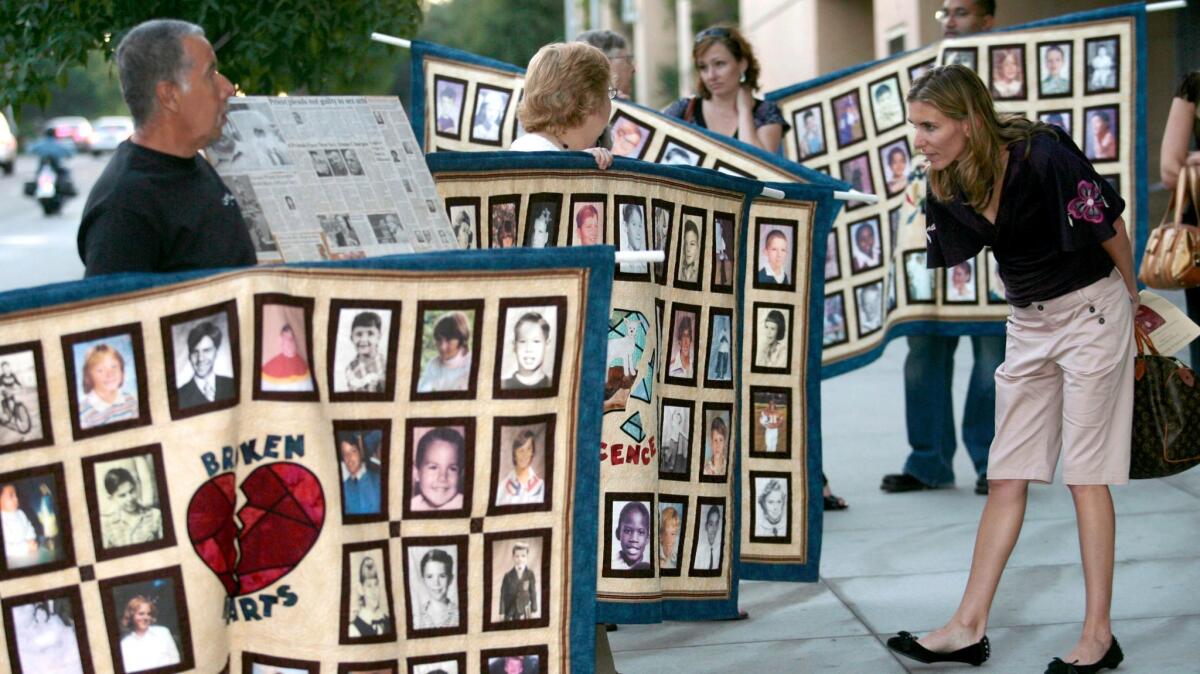Op-Ed: Harvey Weinstein’s alleged pattern of harassment echoes that of child sexual abusers

- Share via
There are many striking aspects to the breathtaking fall of Harvey Weinstein — the volume of women who have come forward, the number of years his alleged behavior remained an open secret, the sheer brazenness of that alleged behavior and, now, the ripple effects it is having well beyond Hollywood.
But as an attorney who has represented scores of victims of child sexual abuse, sexual assault and sexual harassment across the country, here’s what I find most remarkable: The similarities between the pattern of harassment that Weinstein allegedly engaged in, and the patterns of abuse that emerge in an entirely different context — namely, the sexual abuse of children in trusted institutions.
Although the specifics are different, the psychological and behavioral dynamics at play among the perpetrators and victims are virtually identical. The way in which Weinstein allegedly wielded power and relied on institutional silence echoes the manner in which Catholic priests were able to perpetrate grievous wrongs against generations of children.
Child abusers are consummately skilled in identifying vulnerable kids and knowing exactly what to say and do to accomplish their goals. Little is left to chance. They use their positions of power to cajole, knowing, for example, that praise and hints of special treatment are necessary in order to begin the process of initiating control.
Predators perfect their modus operandi through the exploitation of multiple victims.
With the obvious difference that Weinstein’s alleged victims weren’t children, he reportedly employed similarly manipulative tactics to achieve his ends, promising movie roles and attempting to normalize such propositions by rattling off the names of other actresses who had purportedly complied.
Some child molesters engage in overtly violent assaults, but it is far more common for the abuser to begin with seemingly innocent touches — the stroke of a knee, a rub of the shoulder, the casual tussle of the hair — before moving on to more invasive physical acts. Predators perfect their modus operandi through the exploitation of multiple victims, learning along the way how to break down a child’s boundaries and resistance.
Although Weinstein allegedly used more of a shock-and-awe approach — the unbelted robe at the business meeting — he, too, appears to have homed in on a certain kind of victim and fine-tuned the process by which he allegedly lured them into rooms, enlisting the help of what a female executive at his company called a “honeypot” of assistants and others to lend such meetings legitimacy.
Fifteen years ago, the dirty secrets of the Roman Catholic Church exploded in big cities and small towns across the country. Since then, we have learned that the church is far from the only place where child molesters turn up. Almost no type of major institution serving children has escaped this shame: Public schools, including the Los Angeles Unified School District; private schools, including the Marlborough School in L.A. and elite New England boarding schools, such as Choate Rosemary Hall, Phillips Exeter and St. Paul’s School; the Boy Scouts of America and the Boys and Girls Club; USA Swimming and USA Gymnastics. The list goes on and on.
The perpetrators in these settings do not rely merely on the silence of their victims. They can also count on the inaction and complicity of others around them, including co-workers and superiors, for whom the avoidance of scandal and institutional humiliation is a strong motivator to look the other way. Tragically, this only strengthens the abuser’s sense of omnipotence and reinforces the victim’s fear and isolation.
While there is no doubt that child victims of sexual abuse are in an infinitely more vulnerable and powerless position than adults subjected to sexual harassment and assault, it is equally true that, with the exception of very young children, both groups of victims react in remarkably similar ways to their treatment and exploitation.
In the vast majority of these situations, victims do not react by physically or verbally resisting the offender, reporting the offender or even fleeing at first touch. Rather, victims become psychologically and emotionally paralyzed, overwhelmed by a combination of fear, self-blame, embarrassment and confusion. They become gripped by an emotional maelstrom in which unanswerable and destructively self-critical questions play over and over again in their minds, often for years on end: Why me? How could I let this happen?
As time goes by, without treatment, these feelings corrode the victim’s self-esteem and dignity, and remaining silent becomes their default coping strategy. The perpetrators not only rely on such silence, they deliberately act to engender it.
It is widely believed by those of us who spend our careers working with victims of sexual abuse that most take their secrets to their graves. When survivors do gather the strength to come forward, it is typically only after someone else has publicly accused the same person, and even then only a minority speak out.
The majority of victims will never get any justice. Except in a handful of states, the statutes of limitations for sexual abuse, assault and harassment are draconian. For sexual abuse and assault, the time limits are generally just a precious few years. These fleeting windows of time do not take into account irrefutable evidence about the long-term effects of sexual abuse and trauma. We need to reexamine these laws even as we dismantle the institutional and corporate environments in which abuse and harassment are allowed to persist.
Paul Mones is an attorney in Los Angeles who represents victims of sexual abuse and assault.
Follow the Opinion section on Twitter @latimesopinion or Facebook
More to Read
A cure for the common opinion
Get thought-provoking perspectives with our weekly newsletter.
You may occasionally receive promotional content from the Los Angeles Times.










